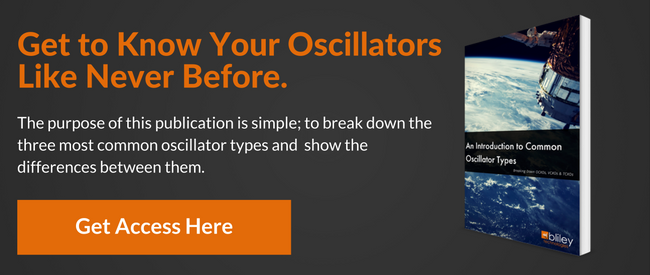
There are many different types of crystal oscillators. OCXOs, TCXOs, and VCXOs are some of the most common types of oscillators. Each have their own advantages and disadvantages. One of the core responsibilities of a lead RF engineer is to pick the oscillators that are an optimal fit for their designs and applications.
If you want to be able to fine-tune your frequency source and get a stable, dependable signal, a voltage-controlled crystal oscillator (VCXO) might be just the solution you’re looking for. Let’s explore the benefits of the VCXO and how you can put them to work in your designs.
What Makes VCXO Oscillators Unique
Just like any other type of crystal oscillator, a VCXO uses vibrations from the crystal to generate a signal. What makes the VCXO unique is the use of diodes to tune the frequency of the signal, a process known as “pulling” the frequency, which is measured in parts per million (ppm).
This is usually done by placing varicap or varactor diodes on either side of the crystal, which together will serve as a variable capacitor by means of applying voltage across the diodes to pull the frequency as desired. This is referred to as control voltage or modulation voltage. The amount of frequency change caused by the control voltage is called the deviation. The deviation vs. the amount of control voltage can be graphically measured and displayed in a format known as slope polarity or transfer function.
Frequency Control and VCXOs
There are a number of factors that influence the degree to which frequencies emitted by a VCXO can be altered, including the amount of control voltage applied, the type of crystal being used, and the circuit design. The range in which a frequency can be tuned at a specific voltage change is called pullability. The higher this is, the higher the amount of tuning range. The amount of pull required will depend on the specific application for the VCXO, but it is important to understand that pulling the frequency can affect it in negative ways.
The process of pulling the frequency makes it less stable and can increase phase noise. The lower the pullability of a VCXO, the more stable and less noisy its signal will be. Temperature drift can also be a problem with this type of oscillator, but incorporating temperature compensation design into the oscillator can help offset this.
Applications for VCXOs
VCXOs are widely used in broadcast and telecommunications equipment. They are used in the design of clock generators to provide timing signals, which keep circuit operations in sync. They are also often used in applications with narrow band phase-locked loops to provide frequency variation.
The VCXO, however, should not be thought of as a distinct category of oscillator that doesn't overlap with other categories. This method of using additional voltage to adjust the frequency can be applied to multiple types of crystal oscillators, including temperature-compensated (TCXO) and oven-controlled (OCXO) designs, so it is not uncommon to see VC/OCXO and TC/VCXO models available for different applications.
Related: Crystal Oscillators: The Beginner's Guide (OCXO, TCXO, VCXO, & Clocks)
The exact specifications for a VCXO will depend on the system in which it is being used, so it is important to be specific on the desired frequency range ahead of time in order for the final product to function as intended.
Whether you’re in the market for a high-quality VCXO or any other type of crystal oscillator, Bliley does it all. Since 1930, our world-class engineers have led the way in oscillator design and performance, and that tradition of excellence continues to this day.
Explore our selection and find the right oscillator for your application.






